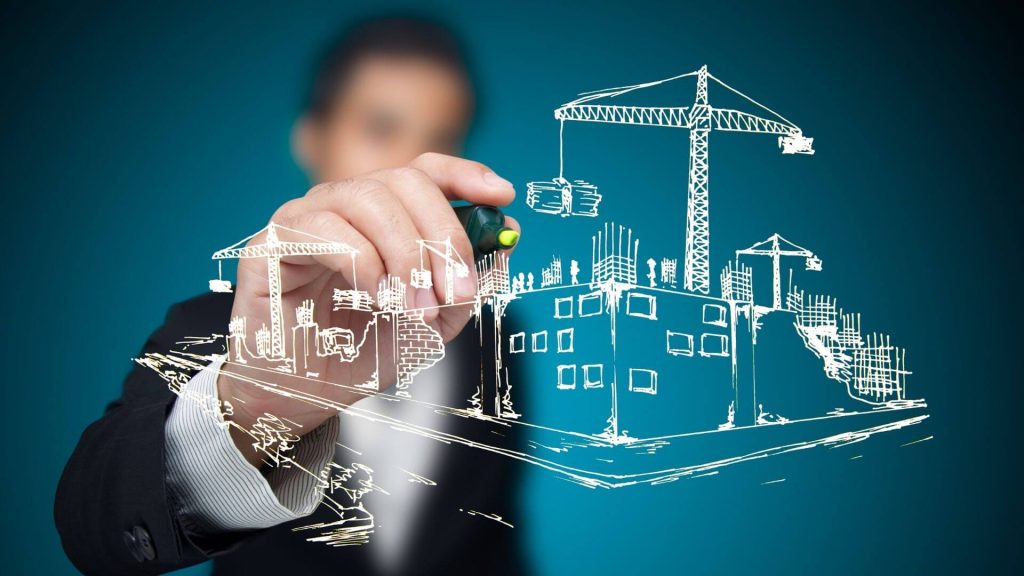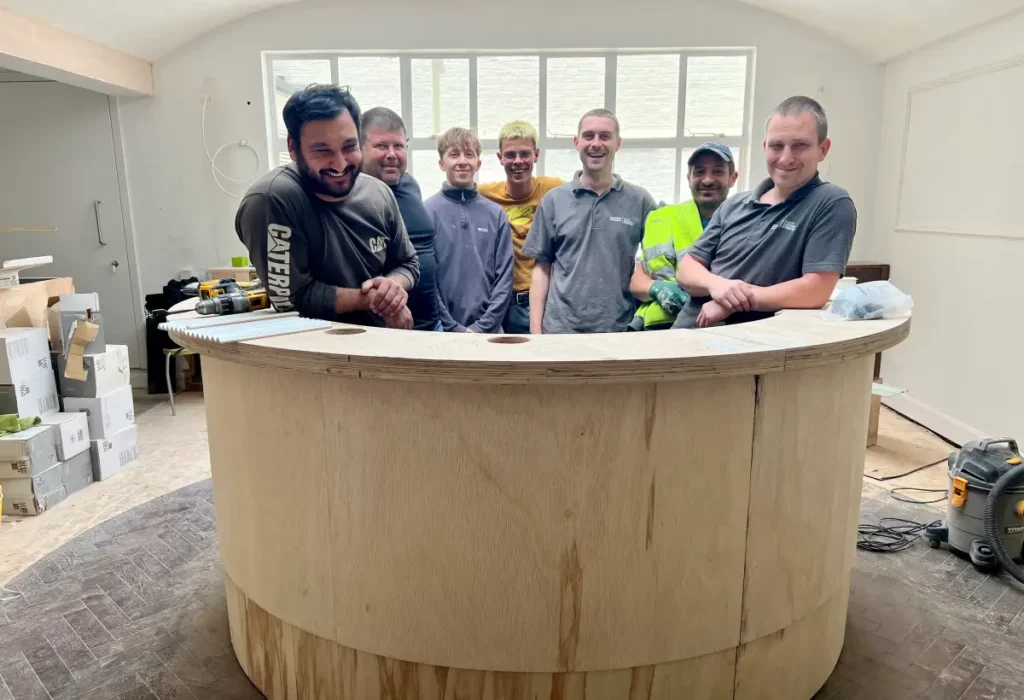Table Of Contents
AI in the fit-out industry is no longer a futuristic concept; it’s already transforming how spaces are designed and built. In this article, we explore how AI in the fit-out industry is driving innovation globally, with real examples showing its influence on office design, construction management, interior creativity, and even business development. The tone is friendly and professional – no dense jargon, just an inviting look at how artificial intelligence is shaping the future of fit-outs, and what it means for companies and clients alike.
AI in Office Design
Artificial intelligence is making office design smarter and more data-driven. Rather than relying solely on intuition or past templates, designers can use AI tools to generate office layout options and optimise them for how people actually work. For example, AI algorithms can analyse how employees move and interact in a workspace. By learning from patterns (like which departments collaborate most or which meeting rooms are underused), AI helps create layouts that boost productivity and comfort. In the US, some forward-thinking tech companies even use AI to simulate different office scenarios – imagine testing five floor plan ideas in minutes to see which one best facilitates teamwork and traffic flow. This was once a manual trial-and-error process, but AI makes it fast and evidence-based.
AI also contributes to healthier, more sustainable office designs. Smart systems can adjust lighting and ventilation based on occupancy and time of day, using machine learning to find the perfect balance between employee comfort and energy efficiency. An AI-equipped office might dim lights and lower air-conditioning in unused areas, then brighten and cool meeting spaces just before a scheduled gathering. These responsive environments make offices more eco-friendly and employee-friendly.

Perhaps one of the most exciting developments is generative design for office layouts. Designers can input parameters (like square footage, number of desks needed, collaboration areas, etc.), and an AI engine can churn out numerous floor plan variations that meet those requirements. For instance, a major architecture firm in the US experimented with AI to plan a new headquarters: the AI was fed thousands of past floor plans and learned to propose new configurations that a human might not have considered. The result was an innovative office layout optimised for movement and interaction, with the AI handling the heavy lifting of crunching spatial data. The human designers then refined the best AI-generated options, ensuring aesthetic and practical considerations were met.
The bottom line is that AI in office design acts as a creative partner. It doesn’t replace the designer’s vision or the client’s preferences, but it provides quick insights and options. This means companies get office designs that are not only visually pleasing, but also backed by data – layouts proven to enhance workflow, collaboration, and employee well-being. And because the AI can do the number-crunching faster, the design process can be more efficient, getting your office fit-out completed and ready to use sooner.
AI in Construction Management
Beyond the creative design phase, AI is making waves in construction management for fit-out projects. Managing a fit-out (or any construction project) involves juggling schedules, budgets, people, and materials, and this is exactly where AI shines by spotting patterns and optimising plans.
One of the key contributions of AI is predictive analytics for project scheduling and budgeting. Fit-out contractors can feed past project data into machine learning models to predict how long a new project might take and where potential delays could occur. For example, if certain tasks (like installing custom lighting or bespoke joinery) typically run over time, the AI will flag this early so project managers can adjust the schedule or allocate extra resources. In the US, large construction firms are using AI-driven project management software that automatically reschedules tasks when there’s a holdup (like a late delivery or a permit delay), minimising downtime. This kind of smart scheduling keeps projects on track and clients informed, reducing the usual stress of uncertainty during a fit-out.

AI is also boosting site safety and quality control in construction management. On some innovative construction sites, AI-powered cameras and sensors monitor progress in real time. They can detect if workers are wearing proper safety gear or if there’s a hazard (for instance, an obstacle in a fire exit route) and alert supervisors immediately. This proactive monitoring is like having an ever-vigilant safety inspector on site 24/7. It’s not science fiction – it’s being trialled on job sites to great effect, significantly reducing accidents. Additionally, drones and 360° cameras equipped with AI software can scan a fit-out project each day and compare it against the digital plans (BIM – Building Information Models). If something is off (say, a wall built slightly out of the planned position or a missing fixture), the system highlights it so the team can correct the issue before it becomes a costly problem. Catching discrepancies early means higher quality finishes and fewer last-minute surprises.
Another area where AI helps construction management is cost control. By analysing tons of data from past projects, AI can provide more accurate estimations and risk assessments. It might predict, for example, that a particular design change typically increases costs by 5%, or that a project planned for winter has a higher chance of weather delays. Armed with these insights, fit-out project managers can make better decisions from the start. According to industry research, applying AI and advanced data analysis could bring cost savings of around 10-15% on construction projects, thanks to efficiencies and avoided mistakes. These savings can potentially be passed on to clients or reinvested into higher-quality materials and finishes for the project.
In summary, AI in construction management means fewer delays, tighter control over budgets, and safer work sites. For clients, this translates to fit-out projects that finish on time (or even early) and within the expected costs, with the peace of mind that every detail is being closely monitored by smart technology as well as experienced project leaders. It’s a blend of hi-tech oversight with human project management expertise. At SEI, we leverage these kinds of AI-driven tools behind the scenes as part of our fit-out services to ensure smooth, efficient project delivery – all without losing the personal touch in managing your project.
(Key ways AI supports construction management:
– Smart Scheduling: Automatically adjusting timelines when issues arise to prevent domino-effect delays.
– Safety Monitoring: Using computer vision to spot hazards or compliance issues in real time, improving on-site safety.
– Quality Assurance: Comparing work in progress against digital plans and flagging inconsistencies early.
– Cost & Risk Analysis: Crunching data to forecast budget needs and project risks, so nothing important is overlooked.)
AI in Interior Design
In the realm of interior design, AI is acting as a creative assistant that can spark inspiration and handle tedious tasks, allowing human designers to focus on the big ideas. When we talk about AI in interior design, it spans everything from generating décor ideas to choosing colour schemes and layouts for a space, whether it’s an office, a retail shop, or a hotel lobby.
One remarkable capability of AI is generating instant design concepts. There are now AI tools where you can upload a photo of an empty room and ask for design suggestions in various styles. In seconds, the AI can produce a visual mock-up – for example, how that bare office might look furnished in a modern minimalist style versus a vibrant creative tech hub style. While these tools are often used by homeowners or hobbyists, professional designers are taking notes. They use advanced versions to rapidly create mood boards and renderings. For instance, an interior designer might use an AI image generator to produce several concepts for a reception area based on keywords (like “warm, welcoming tech startup vibe”) and then show those to the client for feedback. This speeds up the early creative phase dramatically. What used to take days of sketching or searching through catalogues can now happen almost instantaneously. The designer still curates and tweaks the ideas, but the AI gives a rich starting point to work from.

AI can also help with materials and finishes selection. Imagine an AI that knows all about the latest fabrics, light fixtures, or flooring options on the market. By inputting certain goals – say, “create a sustainable and cost-effective interior with a coastal theme” – the AI could suggest specific eco-friendly materials, paints in soothing blues and greens, and furniture pieces made from recycled materials. It does this by analysing vast databases of products and design case studies. This kind of tool can ensure the design is not only stylish but also hits targets like budget limits or sustainability criteria. In the US, many forward-looking interior design firms are integrating AI into their process in this way, using it as a research assistant that never tires. It combs through trend forecasts, building codes, and client preferences in seconds. The result is a design process that’s thorough and tailored – no detail overlooked.
Another area where AI supports interior design is personalisation. AI algorithms can learn client preferences from past projects or even from something as simple as a Pinterest board the client loves. By spotting patterns in what a client tends to like (be it certain colours, mid-century furniture, or open, airy layouts), the AI can guide the designer toward options the client will likely appreciate. This makes the collaborative process between client and designer smoother, as the first ideas presented are already aligned with the client’s taste.
Crucially, designers are finding that AI frees them from spending hours on administrative or technical tasks. Things like calculating precise room measurements for furnishings or ensuring every selected item fits the budget can be automated. When an AI tool handles these time-consuming chores, designers can invest more time in creativity and client interaction, which are the aspects of interior design that require the human touch and intuition.
It’s important to note that while AI brings speed and smarts to interior design, the human element remains key. Interior design is ultimately about how a space feels to people. An algorithm can propose a layout that maximises space usage or a colour palette that’s trending, but only a human designer can understand the subtle emotional response a client wants when they step into their new office or shop. At SEI, our design team uses AI as a helpful guide – never as a substitute for imagination or experience. The technology might suggest, “Green biophilic walls are popular for wellness-focused offices,” but it’s our designers who know how to incorporate that idea in a way that fits our client’s unique brand and culture. The fusion of AI-driven insights with human creativity leads to interior designs that are innovative yet authentic to each client.
AI in Business Development
AI’s influence isn’t confined to design and construction – it’s also reshaping business development in the fit-out industry. Business development is all about building relationships, understanding market needs, and delivering great proposals to win projects. Here, AI serves as a strategic assistant, helping companies like fit-out contractors and design firms to make smarter decisions on how to grow and serve their clients better.
One significant application is in analysing data to identify trends and opportunities. For example, an AI system can sift through vast amounts of market data, economic indicators, and even social media trends to predict which sectors are growing. A fit-out company might use these insights to discover that, say, tech start-ups in a certain city are expanding rapidly and looking for modern office spaces. With that knowledge, the business development team can proactively tailor their services and marketing to that booming niche. In the US, many companies use AI analytics tools to forecast real estate and construction trends, effectively spotting where the next wave of fit-out projects might come from. By knowing this in advance, they stay one step ahead of competitors (none of which we’ll name here!) and position themselves as the go-to expert for those upcoming needs.
AI also enhances how companies manage client relationships. Customer Relationship Management (CRM) systems infused with AI can prioritise leads and even suggest the best approach to engage a potential client. For instance, if a property developer has interacted with certain parts of a company’s website (like reading about sustainable design), an AI-equipped CRM might flag that sustainability is a key interest for that client. The business development team can then highlight relevant experience in sustainable fit-outs when they reach out, making the conversation more pertinent and valuable. This personalised approach, powered by AI insights, can improve win rates because the client feels understood and gets information exactly aligned with their interests.

The proposal process itself can benefit from a touch of AI. Writing and assembling proposals for fit-out projects can be time-consuming. AI tools can help draft proposal sections based on past successful bids, ensuring no key information is missed. They can also quickly pull together data like timelines, cost breakdowns, and even suggested design ideas from the company’s knowledge base. Imagine preparing a detailed office fit-out proposal that usually might take a week, but with AI assistance, the first draft is ready in a day, allowing the team to spend more time customising and refining the pitch rather than compiling standard content. Some firms in the US are already using AI to auto-generate proposal drafts and then letting their human experts polish the tone and details. The end result is a professional, thorough proposal produced in a fraction of the time.
Another facet is marketing and outreach. AI can help business development teams decide where to focus their marketing efforts. By analysing which blog posts, case studies, or social media updates get the most engagement, AI identifies what content resonates with potential clients. If, for example, website analytics (powered by AI) show that an article about “AI-driven office design trends” is frequently read and leads to inquiries, the business team knows that the topic is a winner. They might then create more content around it or host a webinar, drawing in an audience interested in modern, tech-savvy fit-out solutions. Essentially, AI takes the guesswork out of marketing strategy by providing evidence of what works.
What does this mean for clients of fit-out companies? It means you are likely to receive a more responsive and tailored service. The company is leveraging smart tools to understand your needs even before the first conversation, ensuring that when you do talk, they already have ideas and solutions aligned with your goals. It also means communication is quicker and more efficient – inquiries don’t fall through the cracks because AI reminders keep the team on top of follow-ups and next steps.
At SEI, we embrace these business development innovations carefully. While we use data insights to guide our strategy, we never forget that business development, at its heart, is about people and trust. An algorithm might tell us who to reach out to, but it’s our team’s friendly voice and genuine commitment that builds the relationship. We see AI as a tool to serve our clients better, by being more responsive, knowledgeable, and proactive, not as a replacement for the personal connections we value in our business.
Conclusion
Artificial intelligence is propelling the fit-out industry into an exciting new era – from smarter designs and efficient builds to savvy business strategies. However, at SEI we remain firmly committed to the core of what we do: human-driven creativity and craft. Our team uses AI innovations to support our work, but every project is still led by experienced professionals who understand the art of design and the nuances of client needs. The result? Fit-out solutions that are both cutting-edge and deeply personalised. It’s this balance of technology and touch that ensures our projects stand out for their quality and character.

In embracing AI, SEI’s goal is to serve our clients with even smarter, more modern fit-out services that don’t compromise on warmth or originality. Whether it’s an office that boosts your team’s productivity or a retail space that perfectly captures your brand, we deliver results enhanced by the best tools available – and crafted with care by our dedicated team. If you’re curious about how AI-infused design and construction can elevate your next project, or you simply want to discuss your ideas with a company that blends innovation with integrity, we invite you to contact us. Let’s work together to create a space you’ll love, with all the benefits of modern technology and the personal service that defines SEI.
Sources
Harvard Business Review – “Artificial Intelligence in Design and Construction”
https://hbr.org/2021/10/artificial-intelligence-in-design-and-construction
Autodesk – “How AI is Revolutionising Construction”
https://www.autodesk.com/redshift/ai-in-construction/
McKinsey & Company – “The Next Normal in Construction: How Disruption is Reshaping the World’s Largest Ecosystem”
https://www.mckinsey.com/industries/engineering-construction-and-building-materials/our-insights/the-next-normal-in-construction
Dezeen – “AI and Architecture: How Artificial Intelligence is Shaping Design”
https://www.dezeen.com/2023/02/14/artificial-intelligence-architecture-guide/
ArchDaily – “The Role of Artificial Intelligence in Interior Design”
https://www.archdaily.com/994215/the-role-of-artificial-intelligence-in-interior-design
IBM – “How AI is Transforming Business Development”
https://www.ibm.com/blogs/watson-health/how-ai-is-transforming-business-development/
Forbes – “How AI is Powering Business Development Teams”
https://www.forbes.com/sites/forbestechcouncil/2021/06/09/how-ai-is-powering-business-development-teams



